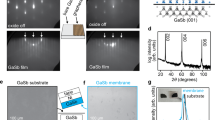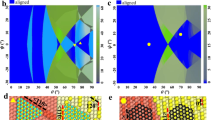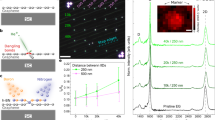Abstract
Although conventional homoepitaxy forms high-quality epitaxial layers1,2,3,4,5, the limited set of material systems for commercially available wafers restricts the range of materials that can be grown homoepitaxially. At the same time, conventional heteroepitaxy of lattice-mismatched systems produces dislocations above a critical strain energy to release the accumulated strain energy as the film thickness increases. The formation of dislocations, which severely degrade electronic/photonic device performances6,7,8, is fundamentally unavoidable in highly lattice-mismatched epitaxy9,10,11. Here, we introduce a unique mechanism of relaxing misfit strain in heteroepitaxial films that can enable effective lattice engineering. We have observed that heteroepitaxy on graphene-coated substrates allows for spontaneous relaxation of misfit strain owing to the slippery graphene surface while achieving single-crystalline films by reading the atomic potential from the substrate. This spontaneous relaxation technique could transform the monolithic integration of largely lattice-mismatched systems by covering a wide range of the misfit spectrum to enhance and broaden the functionality of semiconductor devices for advanced electronics and photonics.
This is a preview of subscription content, access via your institution
Access options
Access Nature and 54 other Nature Portfolio journals
Get Nature+, our best-value online-access subscription
$29.99 / 30 days
cancel any time
Subscribe to this journal
Receive 12 print issues and online access
$259.00 per year
only $21.58 per issue
Buy this article
- Purchase on Springer Link
- Instant access to full article PDF
Prices may be subject to local taxes which are calculated during checkout




Similar content being viewed by others
Data availability
The data that support the findings of this study are available from the corresponding author upon reasonable request.
References
Chen, C. Q. et al. GaN homoepitaxy on freestanding (1100) oriented GaN substrates. Appl. Phys. Lett. 81, 3194–3196 (2002).
Kwon, O. et al. Monolithic integration of AlGaInP laser diodes on SiGe/Si substrates by molecular beam epitaxy. J. Appl. Phys. 100, 13103 (2006).
Matsunami, H. & Kimoto, T. Step-controlled epitaxial growth of SiC: high quality homoepitaxy. Mater. Sci. Eng. R. Rep. 20, 125–166 (1997).
Vaisman, M. et al. Effects of growth temperature and device structure on GaP solar cells grown by molecular beam epitaxy. Appl. Phys. Lett. 106, 063903 (2015).
Voigtländer, B., Weber, T., Šmilauer, P. & Wolf, D. E. Transition from island growth to step-flow growth for Si/Si (100) epitaxy. Phys. Rev. Lett. 78, 2164–2167 (1997).
Luan, H.-C. et al. High-quality Ge epilayers on Si with low threading-dislocation densities. Appl. Phys. Lett. 75, 2909–2911 (1999).
Currie, M. T., Samavedam, S. B., Langdo, T. A., Leitz, C. W. & Fitzgerald, E. A. Controlling threading dislocation densities in Ge on Si using graded SiGe layers and chemical-mechanical polishing. Appl. Phys. Lett. 72, 1718–1720 (1998).
Andre, C. L. et al. Impact of dislocation densities on n+∕ p and p+∕ n junction GaAs diodes and solar cells on SiGe virtual substrates. J. Appl. Phys. 98, 14502 (2005).
Lee, M. L., Antoniadis, D. A. & Fitzgerald, E. A. Challenges in epitaxial growth of SiGe buffers on Si (111), (110), and (112). Thin Solid Films 508, 136–139 (2006).
Chen, R. et al. Nanolasers grown on silicon. Nat. Photonics 5, 170–175 (2011).
Ebert, C. B., Eyres, L. A., Fejer, M. M. & Harris, J. S. Jr MBE growth of antiphase GaAs films using GaAs/Ge/GaAs heteroepitaxy. J. Cryst. Growth 201-202, 187–193 (1999).
Lee, M. L., Fitzgerald, E. A., Bulsara, M. T., Currie, M. T. & Lochtefeld, A. Strained Si, SiGe, and Ge channels for high-mobility metal-oxide-semiconductor field-effect transistors. J. Appl. Phys. 97, 1 (2005).
Bean, J. C., Sheng, T. T., Feldman, L. C., Fiory, A. T. & Lynch, R. T. Pseudomorphic growth of GexSi1−x on silicon by molecular beam epitaxy. Appl. Phys. Lett. 44, 102–104 (1984).
Fitzgerald, E. A. et al. Totally relaxed GexSi1−x layers with low threading dislocation densities grown on Si substrates. Appl. Phys. Lett. 59, 811–813 (1991).
Song, T. L., Chua, S. J., Fitzgerald, E. A., Chen, P. & Tripathy, S. Strain relaxation in graded InGaN/GaN epilayers grown on sapphire. Appl. Phys. Lett. 83, 1545–1547 (2003).
Massies, J. & Grandjean, N. Oscillation of the lattice relaxation in layer-by-layer epitaxial growth of highly strained materials. Phys. Rev. Lett. 71, 1411–1414 (1993).
Daruka, I. & Barabási, A.-L. Dislocation-free island formation in heteroepitaxial growth: a study at equilibrium. Phys. Rev. Lett. 79, 3708–3711 (1997).
Kim, Y. et al. Remote epitaxy through graphene enables two-dimensional material-based layer transfer. Nature 544, 340–343 (2017).
Kong, W. et al. Polarity governs atomic interaction through two-dimensional materials. Nat. Mater. 17, 999–1004 (2018).
Li, X. et al. Large-area two-dimensional layered hexagonal boron nitride grown on sapphire by metalorganic vapor phase epitaxy. Cryst. Growth Des. 16, 3409–3415 (2016).
Attolini, G. et al. Optical and structural characterization of LP MOVPE grown lattice matched InGaP/GaAs heterostructures. Mater. Sci. Eng. B 91-92, 123–127 (2002).
Kato, T., Matsumoto, T. & Ishida, T. Raman spectral behavior of In1-xGaxP (0 < x < 1). Jpn. J. Appl. Phys. 27, 983–986 (1988).
Lee, H. et al. Study of strain and disorder of InxGa1−xP/(GaAs, graded GaP)(0.25 ≤ x ≤ 0.8) using spectroscopic ellipsometry and Raman spectroscopy. J. Appl. Phys. 75, 5040–5051 (1994).
King-Ning, T., Mayer, J. W. & Feldman, L. C. Electronic Thin Film Science for Electrical Engineers and Materials Scientists (Macmillan, 1996).
Matthews, J. W. & Blakeslee, A. E. Defects in epitaxial multilayers: I. Misfit dislocations. J. Cryst. Growth 27, 118–125 (1974).
Freundlich, A., Bensaoula, A., Bensaoula, A. H. & Rossignol, V. Interface and relaxation properties of chemical beam epitaxy grown GaP/GaAs structures. J. Vac. Sci. Technol. B 11, 843–846 (1993).
Morales, F. M. et al. Microstructural improvements of InP on GaAs (001) grown by molecular beam epitaxy by in situ hydrogenation and postgrowth annealing. Appl. Phys. Lett. 94, 41919 (2009).
Bae, S.-H. et al. Unveiling the carrier transport mechanism in epitaxial graphene for forming wafer-scale, single-domain graphene. Proc. Natl Acad. Sci. USA 114, 4082–4086 (2017).
Shim, J. et al. Controlled crack propagation for atomic precision handling of wafer-scale two-dimensional materials. Science 362, 665–670 (2018).
Kim, J. et al. Layer-resolved graphene transfer via engineered strain layers. Science 342, 833–836 (2013).
Bae, S.-H. et al. Integration of bulk materials with two-dimensional materials for physical coupling and applications. Nat. Mater. 18, 550–560 (2019).
Kum, H. et al. Epitaxial growth and layer-transfer techniques for heterogeneous integration of materials for electronic and photonic devices. Nat. Electron. 2, 439–450 (2019).
Han, Y. et al. Sub-nanometre channels embedded in two-dimensional materials. Nat. Mater. 17, 129–133 (2018).
Hÿtch, M. J., Snoeck, E. & Kilaas, R. Quantitative measurement of displacement and strain fields from HREM micrographs. Ultramicroscopy 74, 131–146 (1998).
Acknowledgements
This work is supported by the Defense Advanced Research Projects Agency Young Faculty Award (award no. 029584-00001), the Department of Energy Solar Energy Technologies Office (award no. DE-EE0008558), the Air Force Research Laboratory (award no. FA9453-18-2-0017), ROHM Co., and LG electronics. Y.H. and D.M. were supported by the National Science Foundation Division of Material Research (award no. 1719875). We are grateful for general support from J.S. Lee (Head of the Materials and Devices Advanced Research Institute, LG Electronics).
Author information
Authors and Affiliations
Contributions
J.K., S.-H.B., K. Lu, Y.H., S.K. and K. Lee conceived the experiment. S.-H.B., K. Lu and H.K. contributed to the epitaxial growth. S.-H.B., K. Lu, B.-S.K., C.K. and J.S. worked on the graphene transfer. Y.H. and S.K. performed the TEM. S.-H.B., K. Lu, Y.H., S.K., D.A.M., K. Lee and J.K. analysed the TEM data. K.Q., W.K. and Y.B. analysed the Raman spectra. C.C. and Y.N. designed and performed the DFT calculation. B.-S.K. and J.L. contributed to the modelling data summary and figure configuration. K. Lu, H.S.K. and P.C. performed XRD. K. Lu and H.K. carried out the EBSD measurement. S.-H.B., K.Q., J.P., M.J. and J.K. contributed to the strain relaxation analysis. All the authors contributed to the discussion and analysis of the results regarding the manuscript. J.K. directed the team.
Corresponding authors
Ethics declarations
Competing interests
The authors declare no competing interests.
Additional information
Publisher’s note Springer Nature remains neutral with regard to jurisdictional claims in published maps and institutional affiliations.
Supplementary information
Supplementary Information
Supplementary Figs. 1–11, discussion.
Source data
Source Data Fig. 1
Raman data, % relaxation data.
Source Data Fig. 2
Lattice constant of InGaP on bare GaAs substrates along the x-axis and lattice constant of InGaP on graphene-coated GaAs substrates along the y-axis.
Source Data Fig. 3
Energy barrier required for the interface sliding of epilayers on graphene/substrates and bare substrates, threshold energy for each situation and critical thickness of the heteroepitaxy film.
Source Data Fig. 4
HRXRD azimuthal off-axis φ scan of the GaP epilayer.
Rights and permissions
About this article
Cite this article
Bae, SH., Lu, K., Han, Y. et al. Graphene-assisted spontaneous relaxation towards dislocation-free heteroepitaxy. Nat. Nanotechnol. 15, 272–276 (2020). https://doi.org/10.1038/s41565-020-0633-5
Received:
Accepted:
Published:
Issue Date:
DOI: https://doi.org/10.1038/s41565-020-0633-5
This article is cited by
-
Single [0001]-oriented zinc metal anode enables sustainable zinc batteries
Nature Communications (2024)
-
Transfer-free chemical vapor deposition graphene for nitride epitaxy: challenges, current status and future outlook
Science China Chemistry (2024)
-
Applications of remote epitaxy and van der Waals epitaxy
Nano Convergence (2023)
-
Photonic van der Waals integration from 2D materials to 3D nanomembranes
Nature Reviews Materials (2023)
-
Van der Waals nanomesh electronics on arbitrary surfaces
Nature Communications (2023)



